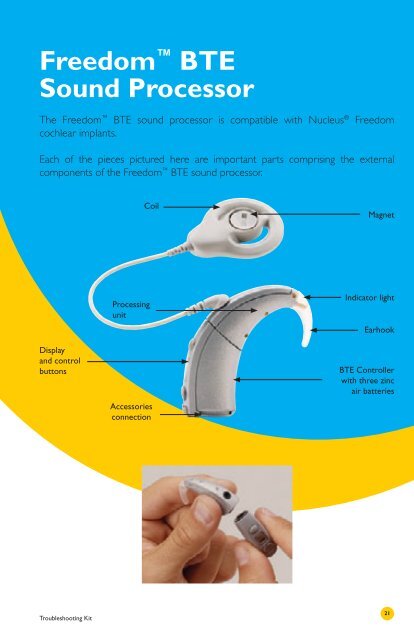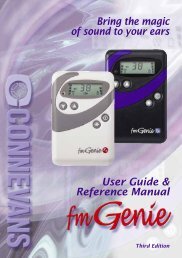Freedom⢠BTE Sound Processor - Cochlear
Freedom⢠BTE Sound Processor - Cochlear
Freedom⢠BTE Sound Processor - Cochlear
You also want an ePaper? Increase the reach of your titles
YUMPU automatically turns print PDFs into web optimized ePapers that Google loves.
Freedom <strong>BTE</strong><strong>Sound</strong> <strong>Processor</strong>The Freedom <strong>BTE</strong> sound processor is compatible with Nucleus ® Freedomcochlear implants.Each of the pieces pictured here are important parts comprising the externalcomponents of the Freedom <strong>BTE</strong> sound processor.CoilMagnetDisplayand controlbuttonsProcessingunitAccessoriesconnectionIndicator lightEarhook<strong>BTE</strong> Controllerwith three zincair batteriesTroubleshooting Kit21
Troubleshooting GuideFreedom <strong>BTE</strong> <strong>Sound</strong> <strong>Processor</strong>Troubleshooting Kit ContentsWhat the kit contains:• 675 PowerOne HP, zinc air batteries, 6 pack• Freedom coil (8cm)• Freedom magnet - #2 beige• Freedom lapel microphone• Freedom monitor earphones• Freedom earhook set (small and large)• Freedom microphone protector• Freedom battery holderBefore troubleshooting step-by-step, conduct a maintenance checkof the equipment.Maintenance CheckConfirm:• Transmitting cable is properly connected.• Cable is not broken or cracked.• Transmitting coil is on the child’s head.Also do the following:• Confirm that the Freedom<strong>BTE</strong> is ‘ON’.• If no sound, turn the Freedom<strong>BTE</strong> ‘Off’ for about 3 seconds,and then ‘On’.DisplayDecreasebuttonCover foraccessoriesconnection• Confirm that the child is using the recommended program setting.Selectbuttonon/offIncreasebuttonProgram 3 in useMicrophone onlyProgram 2 in useTelecoil only• Identify whether help messages are displayed on the LCD.22Troubleshooting Kit
Help message H1 = battery flat• Change the batteries(ensure that all of thebatteries are changed).• Ensure that all of thebatteries are insertedcorrectly – flat/positiveside on the bottom).• Check using the lapelmicrophone (refer to lapelmicrophone instructions below).- If sound improves, disconnect.- If sound does not improve; change battery holder.• Change the battery holder (ensure new batteries are fitted)Help message H2 = battery low• Replace/recharge all of the batteries.Help message H3 = coil error• Check that the coil is fully inserted in the socket.• Check that the coil is correctly located overthe Implant.• Check for cable damage.MagnetGripBattery holderPull outHelp message H4 = sound/stimulation error• Check using the lapel microphone.• Change the processing unit (use backup processing unit).• Contact the child’s cochlear implant clinician.Help message H5 = MAP corrupt• Change the processing unit (use backup processing unit).• Contact the child’s cochlear implant clinician.Troubleshooting Kit23
Presented Complaints:No sound/intermittent sound (help messages H1, H2, H3, H4)• Change the batteries (ensure that all of the batteries are changed).• Check using the lapel microphone.• Check that the coil is fully inserted in the processing unit socket(and correctly located over the implant).• Change the coil.• Change the controller (ensure new batteries are fitted, can also trythe Bodyworn controller at this stage).• Change the processing unit (use back-up processing unit or contact thechild’s cochlear implant clinician).<strong>Sound</strong> unclear/muffled• Check the LCD for help message (H4 = see steps 2 – 5,H5 = contact your clinician).• Check using the lapel microphone. Determine whetherthe sound improves.• Disconnect the lapel microphone and remove the microphone cover.Determine whether the sound improves.• Replace the microphone cover, if the sound does not improve.• Replace the processing unit (use back-up processing unit or contact thechild’s cochlear implant clinician).LCD blank (but sound OK)• Stop the power to the processing unit and then restart it.• Change the controller (return the suspected faulty controller).<strong>Sound</strong>s uncomfortably loud• Contact the child’s cochlear implant audiologist.Indicator lightWhen the indicator light is turned on, it:• Flickers when incoming sounds are being received.• Shows a slow flash rate as a low battery warning.• Shows a fast flash rate for all other warnings e.g. the coil is off itsposition over the implant, or there is a sound error (help message H4).To stop the alarm, push any button.24Troubleshooting Kit
Microphone and accessoriesMonitor earphones can be used by a hearing person to listen to the soundsignal from either of the following:• Microphone• Built-in telecoil• Microphone and built-in telecoil,together• Accessory• Accessory and microphone togetherTo use the lapel microphone:• Use your fingernail to lift thesocket cover.• Push the accessory pluginto the socket.• Push both the increase anddecrease buttons at the sametime for a few seconds toactivate the accessory.• ‘EA’ (external accessory) shows brieflyon the display while the changeis happening.To use the monitor earphones:• Ensure the sound processor is on.• Plug the monitor earphones intothe base of the <strong>BTE</strong> controller.- Caution: Do not use force.• Press any button on the <strong>BTE</strong>controller, for more than onesecond, to activate the earphones.• Should you wish to test an accessory,plug it in to the monitorearphone connector.• Listen to sounds.Monitor earphones only indicate that sound can be heard. They do notindicate the quality of sound as heard by the sound processor user.Troubleshooting Kit25
Electromagnetic interferenceMove away from any electronic device that may be causing interference, e.g.buzzing sounds or distorted speech.Most electronic devices produce electromagnetic fields. Headset cables, likeantennae, pick them up. Common sources of interference include:• Radio and TV transmission towers• Mobile phone towers• Shopping center and airport security systems• Some digital mobile phones• Battery chargersThe electronic interference (EMI) will be no louder than the programmedlevels and will neither hurt nor damage the processor. If buzzing is still heard,or distorted speech, turn off the speech processor, take off the coil andconsult the implant clinician26Troubleshooting Kit



